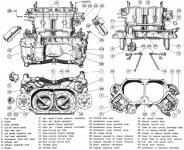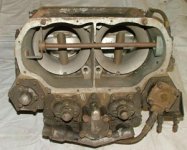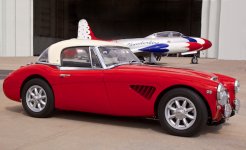Not so, I believe the carburettor used on the Merlin engine was a Claudel Hobson.
BMC owned SU (Skinner Union) and R-R & B designed their own versions and had SU make them.
Then the Internet needs to be corrected, because there are a lot of pages saying the Merlin used an SU pressure carb--so it's not like those used in our cars, but still--including the following:
"Another improvement was made by moving the fuel outlet from the bottom of the
S.U. carburettor to exactly halfway up the side, which allowed the fuel to flow equally well under negative or positive g.[SUP]
[46][/SUP] Further improvements were introduced throughout the Merlin range: 1943 saw the introduction of a
Bendix-Stromberg pressure carburettor that injected fuel at 5
pounds per square inch (34
kPa; 0.34
bar) through a nozzle directly into the supercharger, and was fitted to Merlin 66, 70, 76, 77 and 85 variants. The final development, which was fitted to the 100-series Merlins, was an S.U.
injection carburettor that injected fuel into the supercharger using a fuel pump driven as a function of crankshaft speed and engine pressures.[SUP]"[/SUP]
from:
https://en.wikipedia.org/wiki/Rolls-Royce_Merlin
"The actual throttle plate that regulates airflow into the engine is located between the intake manifold and the variable venturi. The suction in the intake manifold draws the fuel�air mixture into the manifold as the throttle opens. The suction in the volume between the throttle and variable venturi is the source for the operation of the variable venturi piston. This basic philosophy was the inspiration for the S.U. aircraft carburetor design. Note the similarity between the automobile and aircraft fuel metering jets and needles in Figure 49 (12 to 16). S.U. type Merlin A.V.T. 44/ 206 or 208 (anti "g") duplex double-entry carburetors were used on the Merlin 61 engine. The maximum fuel demand is 135 gallons per hour. The fuel, at fuel pump pressure, flows through an 8 ~ 10 psi reducing valve before entering the fuel supply connection (1) (Fig. 49)."
pic:

-- and --
"
The SU twin-choke up-draught type Merlin carburettor fitted to this engine is, with the exception of the separate boost control unit, entirely self-contained and is arranged to be fully automatic in its functioning, with the result that the responsibilities of the pilot are reduced to their simplest form and the danger of engine damage resulting from incorrect setting is reduced. "
from: https://www.airpages.ru/eng/mt/merlin25.shtml
-- and --
"The final development was an SU injection carburettor which injected fuel into the supercharger using a fuel pump driven as a function of crankshaft speed and engine pressures, which was fitted to the 100 series Merlins. Production of the Griffon-engined Spitfire Mk. XII had begun the year before."
from: https://www.gracesguide.co.uk/Rolls-Royce_Engines:_Merlin
There's a slightly used one for sale here: https://spitfirespares.co.uk/power.html
pic:

Ah, heck, just google 'merlin engine su carburettor.' I got 12,100 hits.
All I got on Claudel-Hobson was:
"Claudel-Hobson was a series of British
carburettors manufactured by the
H. M. Hobson (Aircraft and Motor) Components Ltd.. First introduced in 1908, they were widely used in British car and aircraft engines in the early 20th Century. Applications included
Sunbeam automobiles as well as
Armstrong-Siddeley,
Bristol,
de Havilland, and
Napier aircraft engines."
(no mention of RR; from:
https://en.wikipedia.org/wiki/Claudel-Hobson)
Side Note: Looks like SU built a pump for the Merlins, too (how the Brits won the Battle with
those is beyond me):
"Rolls-Royce wanted to use the speed-density method of controlling the fuel-air ratio. It found that the Skinners Union carburetor division of the Morris group had already manufactured a reciprocating swash-plate pump, although it was much too small for the purpose. Rolls-Royce then invited SU to produce a larger pump of the same design, and to develop a control system for it with Rolls-Royce. SU engineers came to the Rolls-Royce plant, and received engine specific data of what the fuel supply produce under all operating conditions. The volume of fuel pumped with the SU swash plate pump can vary from no fuel to full fuel by changing the angle of the swash plate, similar to the method used to control the pitch of a helicopter's rotor blades. In the case of the fuel pump, intake and exhaust manifold pressure, intake manifold temperature and engine speed combine to control the swash plate angle."
from:
https://www.enginehistory.org/Accessories/HxFuelSys/FuelSysHx09.shtml


 Hey there Guest!
Hey there Guest!
 smilie in place of the real @
smilie in place of the real @
 Pretty Please - add it to our Events forum(s) and add to the calendar! >>
Pretty Please - add it to our Events forum(s) and add to the calendar! >> 






 A friendly reminder - be careful what links you click on here. If a link is posted by someone you don't know, or the URL looks fishy, DON'T CLICK. Spammers sometimes post links that lead to sites that can infect your computer, so be mindful what you click.
A friendly reminder - be careful what links you click on here. If a link is posted by someone you don't know, or the URL looks fishy, DON'T CLICK. Spammers sometimes post links that lead to sites that can infect your computer, so be mindful what you click.